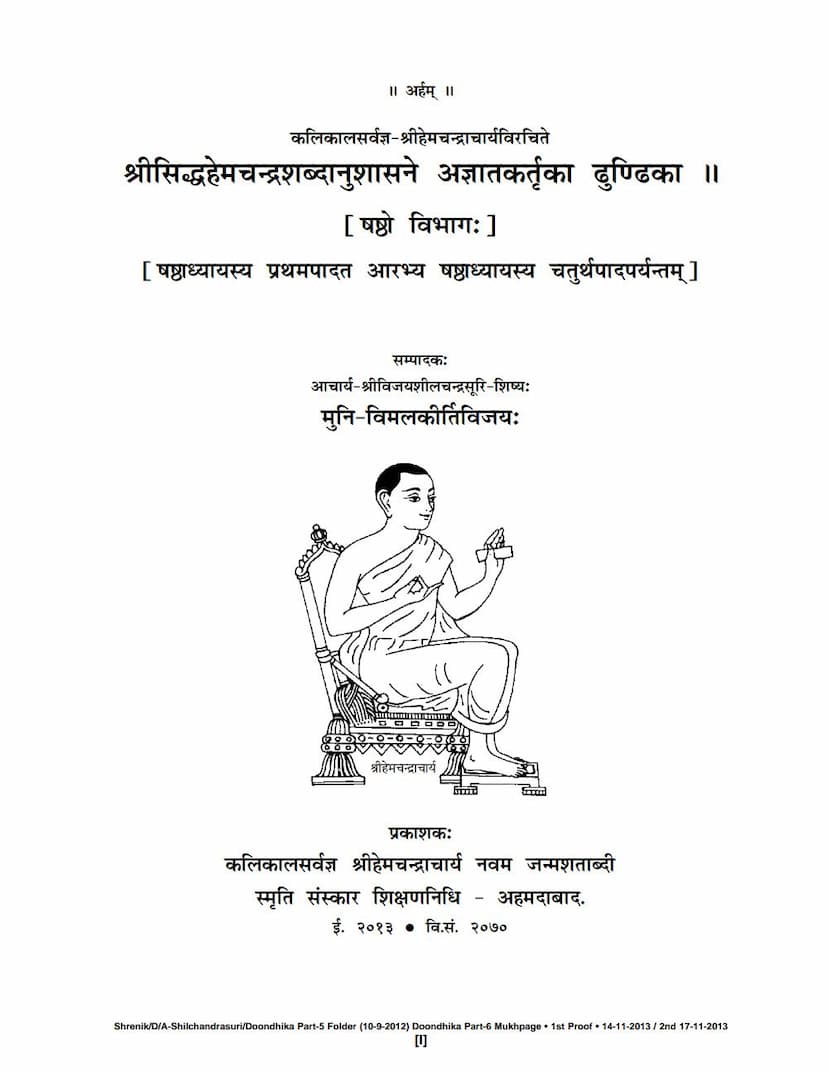Siddha Hemchandra Shabdanushasane Agyat Kartuka Dhundika Part 06
Added to library: September 2, 2025

Summary
The provided Jain text, titled "Siddha Hemchandra Shabdanushasane Agyat Kartuka Dhundika Part 06," authored by Vimalkirtivijay, is the sixth volume of a commentary on the famous Sanskrit grammar text "Siddha Hemchandra Shabdanushasanam" by Acharya Hemchandracharya. This specific volume, compiled by Muni Vimalkirttivijay, disciple of Acharya Vijayshilchandra Suri, covers the latter part of the sixth chapter (from the first to the fourth pada) of the grammar.
Here's a comprehensive summary of the content based on the provided pages:
Overall Purpose:
This volume of the "Dhundaika" commentary focuses on the Taddhita (तद्धित) section of the Siddha Hemchandra Shabdanushasanam, specifically within the sixth chapter. The primary goal of the "Dhundaika" is to provide detailed explanations and etymological derivations (साधना) for the examples and counter-examples presented in the primary commentary (vritti) of Hemachandracharya's grammar. This particular volume delves into the intricacies of forming derivative words (taddhita suffixes) from various roots and stems, as prescribed by the rules of grammar.
Key Content and Structure:
The text is meticulously structured by the editor, Muni Vimalkirttivijay, who has based his work on handwritten manuscripts found in Jain Gyan Mandir, Patan. The volume begins with introductory pages and then systematically presents the grammatical rules (sutras) from the sixth chapter of the Siddha Hemachandra Shabdanushasanam, followed by their extensive explanations.
Key Features Highlighted:
- Editor and Publisher: The volume is edited by Muni Vimalkirttivijay, a disciple of Acharya Vijayshilchandra Suri, and published by the Nav Janmashatabdi Smruti Sanskar Shikshannidhi in Ahmedabad, commemorating the 9th birth centenary of Acharya Hemchandracharya.
- Content Scope: The text covers the first, second, third, and fourth padas (sections) of the sixth chapter. The table of contents explicitly lists the topics covered under each pada, primarily focusing on Taddhita rules.
- Commentary Style: The commentary, known as "Dhundaika," is characterized by its detailed breakdown of words, explaining their derivation from roots, the application of grammatical rules, and providing examples and counter-examples. It often cites other grammatical texts and commentaries for support or clarification, as indicated in the "List of Books Used for Editing" (संपादनोपयुक्तग्रन्थसूचिः).
- Appendices: The volume includes two appendices:
- Appendix 1: A list of approximately 100 pratyayas (suffixes) like san, ru, etc., detailing their application based on grammatical rules (sutra), case endings, meanings, and the words to which they are applied. Bold type is used for suffixes with anubandhas (indicatory letters), and parentheses for suffixes without them.
- Appendix 2: A list of example and counter-example words discussed in the text, including those whose sadhana is provided in the Dhundaika, even if they originate from grammatical ganapathas (list of word-roots).
- Grammatical Focus: The primary focus is on the Taddhita (तद्धित) affixes, which are applied to stems to form new words, often indicating relationship, belonging, or origin. The text meticulously explains how these suffixes are added according to the rules laid down by Hemachandracharya, including changes in vowels (vriddhi), additions of letters, and the context of their usage.
- Specific Examples: The text is replete with examples like Aupagavah (from Upagu, illustrating the rule of ana- suffix), Kaapatavah, Gargyah, Vaatsyah, Gargi, Vaatsi, Gaayano, Vaatsyaayanah, Shaaleeyah, Maaleeyah, Naad(d)iyo, Vaahanikeyah, Paurvaa(a)grahayanikah, and many others. The commentary breaks down each example, tracing the derivation of the word to its root and applying the relevant rules and exceptions.
- Publisher's Note: The publisher's note expresses joy in releasing this sixth volume of the Dhundaika on the Taddhita section of Hemachandracharya's grammar. It acknowledges the effort of Muni Vimalkirttivijay in transcribing and editing the work from manuscripts and thanks Shri Kirit Graphics for the printing. It also highlights the trust's literary activities, including honoring scholars and publishing ancient texts.
- Editor's Note: The editor's note explains the purpose of the Dhundaika – to provide the sadhanika (derivation) of examples found in the vritti of the Siddh-Hemachandra. It clarifies that this volume covers the Taddhita chapter from the sixth chapter of the grammar and mentions the source manuscript. It also expresses gratitude to Muni Sailokyamandanvijayji Maharaj for clarifying ambiguous points during the editing process.
- Dedication: The book is dedicated to the entire community of Shasan Samrat Shri Vijay Nemisurishwarji Maharaj, who is credited with revitalizing the study and teaching of Siddh-Hemachandra Shabdanushasanam.
In Essence:
This volume is a scholarly work dedicated to the detailed grammatical analysis of Sanskrit word formation, specifically focusing on the Taddhita affixes within the sixth chapter of Hemachandracharya's grammar. It serves as an invaluable resource for students and scholars of Jainism and Sanskrit grammar, offering a deep dive into the linguistic principles laid down by one of India's most revered grammarians. The meticulous editing and compilation by Muni Vimalkirttivijay make this an accessible and comprehensive study of this complex grammatical domain.